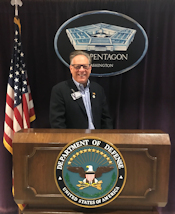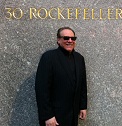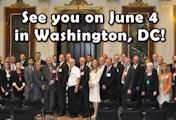NanoBusiness Interview – Josh Wolfe, Co-founder & Managing Partner Lux Capital Management
Posted on March 14th, 2011 | No Comments »
In this month’s interview, we talk to Josh Wolfe, Co-Founder and Managing Partner of Lux Capital Management. Mr. Wolfe manages Lux’s investments in Nanosys, Cambrios, Siluria and serves on the Board of Directors of Kurion, Silicon Clocks, Crystal IS and Lux Research. Before forming Lux Capital, he worked in Salomon Smith Barney’s Investment Banking group, in capital markets at Merrill Lynch on its Financial Futures & Options/Government Strategy desk and at Prudential Securities in Municipal Finance.
Prior to venturing into the financial world, Mr. Wolfe published cutting-edge AIDS-immunopathology research in Cell Vision and The Journal of Leukocyte Biology, in leading medical-immunology journals. He serves as co-founder and Chairman of the Board of Trustees of Coney Island Prep, the first charter school in his native Coney Island, Brooklyn, and has been actively involved with the East Harlem School at Exodus House for over a decade. The son of a public school teacher, Josh is passionate about science, inner-city education and kids having a deep desire to learn and the right heroes.
Josh is a columnist with Forbes, Editor for the Forbes/Wolfe Emerging Tech Report and host of a show on the Forbes Video Network. He has been an invited guest to the White House and Capitol Hill to advise on nanotechnology and emerging technologies, a lecturer at MIT, Harvard, Yale, Cornell, Columbia and NYU, and a frequent guest on CNBC and CNN. Mr. Wolfe graduated from Cornell University with a B.S. in Economics and Finance.
In this interview, we talk to Josh about Lux Capital’s approach to venture capital investing and discuss some of the firm’s investments in nano and other advanced technology. We hope you enjoy the interview. – Steve Waite
SW: It’s great to be speaking with you today, Josh. Thanks for spending some time with us. You mentioned investing in nuclear. Nuclear technology was derided by environmentalists decades ago, but several prominent and outspoken activists have changed their tune. How big is the opportunity in nuclear today?
JW: There’ve been two things holding back nuclear: fear and waste. On the former it’s a remarkable shift. Environmentalists, once vociferous opponents, have become voracious proponents. To favor carbon reduction is to favor nuclear production. It’s the only rational way to have zero-carbon, not just low carbon, but zero-carbon base-load electricity production. 20% of US electricity is from nuclear, 80% of France, 16% globally and rising.
Remarkably, many people don’t know this, but because of a program called Megatons to Megawatts, about half the uranium our domestic reactors consume comes from Russian nuclear warheads. So amazingly, roughly one in every ten electrons you are consuming right now comes from dismantling of Cold War weapons. Anyway, Lux spent a year scouting the entire fuel cycle, from uranium miners to modular reactors to fuel enrichment, and determined that for a variety of reasons, none of them were venture-backable. The single biggest unsolved problem, particularly in the US was nuclear waste.
SW: Dealing with nuclear waste is obviously a major issue. What kinds of solutions exist today to deal with nuclear waste that weren’t available in the past?
JW: The first thing to know is there are two kinds of nuclear waste: spent fuel, which are the rods inside our 104 domestic reactors and the 440 global reactors. What we call waste, France calls fuel because they reprocess the spent fuel rods; 95% of the fuel is still in them, but proliferation is a concern so since Jimmy Carter’s reign, we have a once-through fuel cycle that stores the rods in casks, basically giant caskets waiting for burial in a some geological repository like Yucca Mountain, in Nevada. But for political reasons that will be trapped in purgatory for years or decades. So there really isn’t a market to go after here.
But the other more important and widely unknown market which has an urgent pain is the defense clean up waste. Most people have never heard of a place called Hanford. It’s in the State of Washington, the size of the State of Delaware and has hundreds of millions of gallons of radioactive waste. Just think about that. That’s bigger than the BP oil spill and twice the cost. And what is most surprising: despite all the rhetoric and punditry on ‘cleantech’ and ‘greentech’ from our political leaders and the media, one out of every four dollars, 25% of the entire DOE (Department of Energy) budget is not spent on solar, batteries, or wind – but on nuclear waste cleanup. This is hands-down the single largest economic opportunity in energy and environment that almost nobody knows or talks about. So we recruited veteran all-stars from the nuclear industry, from government, even Patrick Moore, Greenpeace founder and huge nuclear convert and quietly started and funded a company called Kurion, named after Madame Curie who discovered radiation. They went on to lock-up the most important technical breakthroughs and can grab the worst radioactive elements and permanently capture and isolate waste from the environment. If the team is successful, this will be one of the most important things I do in my life and one of the most financially lucrative things I’ve done for our investors.
SW: While we are on the topic of investing in energy, what is your view of prospects for digital power over the next 3-5 years?
JW: This is another critical area and one where like nuclear, Lux had a variant perception, a differing view. Everyone believes in energy efficiency. But I think they’re crazy. Everyone believes if things were more energy efficient we’d use less energy but they have it exactly and completely backwards. I wish I’d discovered the reason why but credit goes back two centuries to Jevon’s Paradox which shows that while individual devices may get more efficient, without any debate, those devices become cheaper and more available. You can do more for the same cost or less. So demand for them goes up and with near certainty, the aggregate energy use goes up. Even Energy Secretary Steven Chu and I have debated this. He hails fridges as energy efficient devices, to which I say amen. But what he misses is that a fridge today while being 75% more efficient than fridges 30 years ago, also are 20% larger and cost 60% of what they did. And the aggregate number of fridges and the aggregate energy demand is way higher. Individual devices get more efficient, aggregate energy goes up. Think of it in Internet terms: if I gave you an efficient T-1 line you’d be doing video conferencing, streaming music, and sending large files. If I put you on a terribly inefficient 56k baud modem you’d pull your hair out!
The secret paradox is that if you want to reduce energy demand: you make things more INEFFICIENT, NOT more efficient. That’s if you believe we should be reducing energy demand, which I am in the minority opposition. Physics and the laws of thermodynamics tell us that life itself is a fight against entropy, disorder – and the only way to prevent entropy is to add energy to a system. The more energy, the more order and the more utility we have. The highly ordered photons in a laser are hugely valuable to society from eye surgery to photonics, whereas the highly entropic photons of a campfire give off heat and nobody will pay much for that. The trick is ordering the photons in a laser requires an enormous amount of energy and a huge amount of waste is chucked over the side.
We have recently announced an investment in Transphorm Inc. that we’re hugely excited about. Transphorm has developed the world’s most energy efficient power conversion technology – eliminating up to 90% of all electric conversion losses. The ability to convert electricity without loss may be to digital power what Intel was to digital logic.
SW: Are there any nano-enabled energy technologies that look attractive to Lux?
JW: The basis of our nuclear waste remediation company, Kurion was born in sophisticated chemistry and material science at the nanoscale. So too our soon to be announced power conversion digital power company coming out of stealth. All of these are based on ever increasing precision control over and ordering of matter at the nanoscale.
SW: I want to go back to your investment process. The second way Lux Capital invests is based on people. Can you give us a few examples of people-driven investments you have made and some insight into the thinking behind them?
JW: Yes, the first is thesis driven. We try to look where others are not looking, seeking out where capital and attention are scarce because that’s usually where valuations are low and future returns high. It’s intellectually gratifying to do these but very risky as we really part from the herd and we have to make sure we do our work and aren’t being contrarian for unfounded reasons. A second way we make our investments is special-situations, finding capital market dislocations where we can invest often times as the last dollars in but lowest average price per share – being a liquidity provider or helping companies when their other investors may be unable to continue financing them. And our third and favorite style is people-driven as you say. As Lux partner Larry Bock says, we bet on two-legged mammals. Darwin was misquoted. It isn’t survival of the fittest, but survival of the most adaptable. So we find the brilliant galvanizing scientist-entrepreneurs-operators, usually some combination of two of those three are embodied in one person. They are the ones that can adapt and turn on a dime, can passionately recruit, can paint a vision on a blank canvas that makes investors want to write checks and employees want to plunge in and take career risk. A phenomenal individual is just that a phenom – a spinning force that pulls people in. The most important thing we can do as a firm is have the good judgment in finding and picking these people and convincing them that Lux is their partner for the next 5 or 10 years. Our investors trust us to allocate their capital and we have to trust these entrepreneurs to do the same for us.
SW: We’ve seen a lot of activity in nanomedicine over the past decade. How does Lux view the potential of nanotech in medicine and health care overall?
JW: It’s as big as energy. The growing trend from big pharma is continued outsourcing to biotechs, academic institutions and embracing external R&D. And the pace of innovation is remarkable. We’ve spun out companies like Genocea in rapid vaccine discovery from Harvard and Berkeley. From MIT in the case of Cerulean and Visterra, focused respectively on nanotech in cancer and pandemic flu. And from Johns Hopkins in using nanotech to deliver drugs through mucus, with MIT legend Bob Langer and his star protégé Justin Hanes in a new company called Kala – which is Hawaiian for passageway.
SW: Returning to the other piece of Lux’s trilogy investment process, what kinds of special situations have you invested in that you are enthused about?
JW: The most interesting might be Everspin. We were founding investors who approached Freescale Semiconductor, which was previously Motorola Semi. They were struggling with a huge debt load from private equity investors after a buyout. And we made them an offer to spin-out their entire advanced memory division which developed non-volatile memory, instant-on memory and help free up their cash flow. It was a win-win for everyone and the company has been growing at triple-digit percentages.
SW: Nanotech is crucial to the future of semiconductors and electronics. How does Lux Capital go about evaluating technologies and companies in this space?
JW: The key particularly in a cyclical industry like semis is who actually is capturing the value. There’s also a secular component with the rise of Asia, contract manufacturing and fab-less models. The only intelligent thing we felt we could do was to avoid the capital intensive businesses and invest after all the capital was invested at the trough of the cycle. In three of our companies over $100 million was invested by either other investors or a corporate parent and we were able to invest at a valuation that was one-tenth, one-quarter or one-third capital invested – and at a time when product was shipping and tech risk was eliminated. These opportunities are rare but are almost surely to present themselves in energy and healthcare too.
SW: It’s been difficult in the venture capital space given the turmoil in financial markets over the past several years. Do you see the pendulum swinging back in favor of venture capital in the years ahead?
JW: I do. I have a self-serving bias here but VC has been the second worst performing asset class for the past decade, save for the S&P. There has been a flood of capital out of equity capital markets into debt markets, which has driven yields of bonds from governments to munis to corporate low and dividend yields of equities high. What I think you’re likely to see is a reversion of capital flows from debt markets into equities. People and institutions and investment advisors will tire of earning 0.5%, 2.5% or 3.5% respectively on 2,10 or 30 year Treasuries. Municipalities are likely to see serious headwinds and retirees who once thought these were tax advantaged vehicles to preserve capital will see them as capital confiscation and maybe even defaults. My speculation would be capital flows first into large-cap blue-chip high-quality dividend yielding US multi-nationals, almost like a Nifty Fifty of yesteryear. Until that gets overdone. Then investors are likely to seek high-growth unlevered equities and that is exactly what creates a new issue, IPO market. For ten years investors have shunned stakes in high-tech startups. The Facebook, Groupon, Twitter, Zynga phenomena are changing that, with blue-chip institutions clamoring to get allocations. It’s possible, if not probable, this trickles into broad demand for tech companies, which tend to be good inflation hedges as technology is broadly deflationary force with non-commoditized offerings and pricing power. So if Fed printing or debasing our dollars to get out of debt leads to inflation, one could see a resurgence of IPOs. Meanwhile, corporations have restructured balance sheets, refinanced debt, extending maturities and lowering coupons and have record amounts of cash on their balance sheets, ripe for M&A. There is always a five-year investment psychological bias, everyone wants to be invested today where they should’ve been five years ago and I think VC is ripe for five plus years of outperformance.
SW: We’ve seen IPO activity pick up over the past year. Should we expect to see some nanotech IPOs in the near future?
JW: Capital markets are setting themselves up for a reversion of capital flows out of bonds (low yielding sovereigns, munis, corporate in the presence of a non-zero inflationary risk) and into equities. First high-quality multi-national dividend yielding equities, then high-growth, unlevered small and mid-cap tech (also a natural deflationary force against inflation risk from central bank paper printing). It will be an IPO picker’s market: meaning, I’m skeptical we’ll see wholesale sectors see a rising tide of investor demand, but individual companies with either the fundamentals or overwhelming buzz (a la current social media phenomenon of Facebook, Groupon, Twitter, LinkedIn) will see strong demand.
SW: Looking ahead, what are the key investment areas that Lux Capital will be focused on?
JW: Two areas we’re in thesis construction mode are what we call “unmet needs for unmanned systems” and “distributed healthcare.” Both are about emerging technology shaking up both defense and demographic trends in the former and healthcare in the latter.
SW: One last question for you, Josh. What have been the three biggest investment lessons you’ve learned since co-founding Lux Capital.
JW: Not sure I can limit it to three, but I’d say that the only certainty is uncertainty – every company is a roller-coaster ride. That being early is the same thing as being wrong. That in tough investments, deal terms can matter more than the price you pay and in great ones, neither really matters. That good investment team processes are as or more important than outcomes. That people not technology are the single most important thing we invest in. That human nature is a constant and greed and fear and all sorts of well catalogued behavioral biases drive people who drive markets and while markets aren’t predictable, group behavior often is. That rational allocation and irrational misallocation of time and capital define all opportunities in investing.
SW: Terrific! Thanks again for your time, Josh. We wish you and your colleagues at Lux Capital all the best in the future.
I have been friends with Josh for 10 years and every time I speak with him I learn about a breakthrough in energy technology. Thank you Josh for your contributions to our Nanotechnology Community and we look forward to seeing you at one of our Conferences in 2011.
Regards,
Vincent Caprio “Serving the Nanotechnology Community for Over a Decade”
Executive Director
NanoBusiness Commercialization Association
203-733-1949
vincent@nanobca.org
www.nanobca.org




